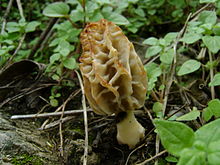Morchella rufobrunnea
| Morchella rufobrunnea | |
|---|---|
 |
|
| Scientific classification | |
| Kingdom: | Fungi |
| Division: | Ascomycota |
| Class: | Pezizomycetes |
| Order: | Pezizales |
| Family: | Morchellaceae |
| Genus: | Morchella |
| Species: | M. rufobrunnea |
| Binomial name | |
|
Morchella rufobrunnea Guzmán & F.Tapia (1998) |
|
| Morchella rufobrunnea | |
|---|---|
| Mycological characteristics | |
| smooth hymenium | |
|
|
cap is conical or ovate |
| stipe is bare | |
|
|
spore print is cream to yellow |
| ecology is saprotrophic | |
| edibility: choice | |
cap is conical
spore print is cream
Morchella rufobrunnea, commonly known as the blushing morel, is a species of ascomycete fungus in the family Morchellaceae. A choice edible species, the fungus was originally described as new to science in 1998 by mycologists Gastón Guzmán and Fidel Tapia from collections made in Veracruz, Mexico. Its distribution was later revealed to be far more widespread after several DNA studies suggested that it is common in the West Coast of the United States, Israel, Australia, and Cyprus.
M. rufobrunnea grows in disturbed soil or in woodchips used in landscaping, suggesting a saprophytic mode of nutrition. Reports from the Mediterranean under olive trees (Olea europaea), however, suggest the fungus may also be able to form tree associations. Young fruit bodies have conical, grayish caps covered with pale ridges and dark pits; mature specimens are yellowish to ochraceous-buff. The surface of the fruit body often bruises brownish orange to pinkish where it has been touched, a characteristic for which the fungus is named, the New Latin rufobrunnea signifying "rufus brown". Mature fruit bodies grow to a height of 9.0–15.5 cm (3.5–6.1 in). M. rufobrunnea differs from other Morchella species by its urban or suburban habitat preferences, in the color and form of the fruit body, the lack of a sinus at the attachment of the cap with the stipe, the length of the pits on the surface, and the bruising reaction. A process to cultivate morels now known to be M. rufobrunnea was described and patented in the 1980s.
...
Wikipedia
